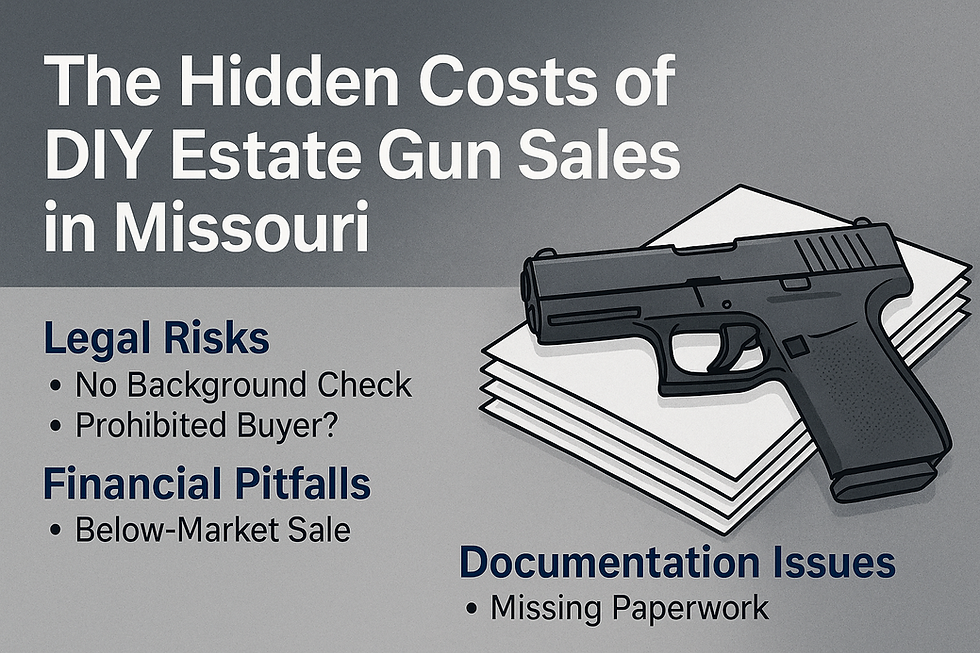Four Photos, Four Firearms: Would You Have Known?
- Drew McDermott

- Aug 21
- 4 min read
Updated: Aug 22
Most people think of a firearm as a rifle, shotgun, or handgun. The ATF thinks differently. In fact, there are firearm components that do not look like guns at all, yet they carry the same legal weight as a complete weapon. That disconnect creates risk for families, attorneys, estate liquidators, and fiduciaries who handle collections without specialized knowledge.
In this post, I want to show you four real examples that qualify as firearms under federal law. If you were sorting an estate or liquidating a collection, would you have recognized them?
1. Remington 700 Serialized Bolt
The Remington 700 is one of the most popular bolt-action rifles in America. Most people would expect the rifle itself to be the regulated item. What surprises many is that the serialized bolt can also be considered the controlled component. Discarding it, shipping it, or selling it without proper handling may expose you to federal violations.

2. Serialized AR-15 Stripped Lower
A stripped AR-15 lower looks like a small chunk of metal, hardly resembling a firearm. Under federal law, however, the lower receiver is the firearm. Every transfer must go through a licensed dealer with a background check. If an executor or estate liquidator throws it into a box of “parts” or sells it at auction as scrap, they have unintentionally mishandled a firearm in the eyes of the ATF.

3. Serialized Polymer Handgun Frame
With modern pistols, the serialized frame often appears incomplete. Without a slide or barrel, it does not look like a finished gun. Yet that bare frame is the legally controlled firearm. Families who come across these during cleanouts frequently underestimate their importance, sometimes treating them like spare plastic or a Toy Gun. Doing so carries significant legal consequences.

4. Sig Sauer Serialized Fire Control Unit (FCU)
Perhaps the least obvious of all is the Sig Sauer Fire Control Unit. It looks like a small internal part, not a firearm. But under the ATF definition, the FCU is the serialized and regulated component. Mishandling it during an estate process is just as serious as mishandling a complete pistol.

The Legal Framework
Federal law defines a firearm far more broadly than most people realize. According to 18 U.S.C. § 921(a)(3) and 27 C.F.R. § 478.11, a firearm includes any frame or receiver of a weapon that is designed to or can readily be converted to expel a projectile by the action of an explosive. That means these four parts, even when incomplete or unrecognizable, meet the legal standard of a firearm.
This is why experienced professionals know that good intentions are not enough. You cannot rely on common sense when federal regulations apply.
Why This Matters in Estates
Estate liquidators, fiduciaries, and attorneys often encounter firearms unexpectedly. The risk is not just in the obvious rifles and pistols. The greater danger is in the serialized parts that do not appear to be firearms.
Here are a few common mistakes:
Selling serialized parts at auction as miscellaneous hardware.
Shipping them without an FFL transfer.
Discarding them as scrap.
Any of these actions could create liability for the estate and potential criminal exposure for those involved.
The Hidden Risk
It is not the guns you see that cause problems. It is the serialized components that do not look like firearms but are treated as firearms under federal law. That is why professionals who work in estate law, liquidation, and fiduciary services should pause before moving forward on their own.

The Safer Solution
At MDRF Enterprises, we identify and legally transfer all types of firearms, including serialized components that most people would miss. Our process removes liability from the estate, protects professionals from accidental violations, and ensures compliance with ATF regulations.
As a Certified Firearms Appraiser aligned with USPAP standards and a licensed FFL operating in St. Louis since 2012, MDRF brings both credibility and experience. When your reputation and compliance are on the line, expertise is not optional.
Final Word from Drew
These four photos prove a simple point: it is not about what a gun looks like, it is about what the ATF defines as a firearm. Families and professionals cannot afford to guess. If you are managing an estate with firearms or serialized parts, call MDRF Enterprises at or visit our Professionals Page. We will handle the details safely, legally, and confidentially.
Serving Saint Louis City, Saint Louis County, and the surrounding Metro area
📞 Call us






Comments